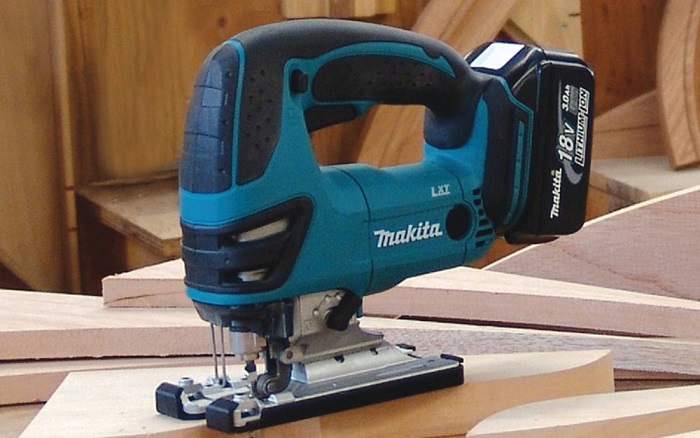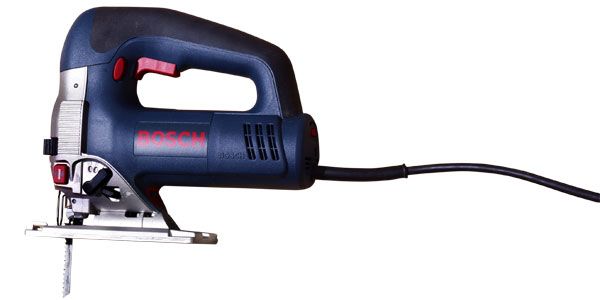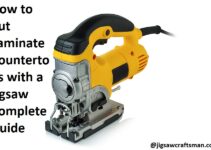Are you looking to buy a jigsaw but are overwhelmed by the sheer variety of choices? Don’t worry, we’ve got you covered.
In this guide, you’ll learn how to choose the right jigsaw for your needs. With our quick tips and tricks, you’ll find yourself walking out with the perfect purchase in no time.
Choosing the right jigsaw can be difficult due to the variety of options available. This guide is meant to help you find the best jigsaw for your particular needs, covering the fundamentals and all of the important details so that you can make an informed decision.
First, it’s important to understand how a jigsaw works and what features one is typically equipped with. In this section, you will learn about jigsaw blade types and other features such as how fast a jigsaw cuts, its power and orbital settings, as well as things like dust collection or other attachments that may improve your user experience.
Next, we will discuss selecting a jigsaw based on its size and ergonomics, such as being able to access tight spaces with ease and having enough room in your hand while using it. We’ll also dive into some safety tips and best practices for using a jigsaw properly.
Finally we’ll talk briefly about picking out accessories for your saw such as belts or dust bags. The goal here is to equip you with all of the necessary knowledge so that you can find the perfect saw for any specific task at hand.
Explanation of the importance of choosing the right jigsaw
Choosing the right jigsaw can be a complex decision. The right jigsaw will depend on the type of work you need to do, the material you are working with, and your budget. Jigsaws have become much more sophisticated in recent years, offering different blade speeds for various applications as well as adjustable pendulum actions for increased safety and accuracy. In order to make sure that you’re choosing the best jigsaw for your needs it is important to understand what each of these features can do for you.
The first thing to consider is what type of material you will be cutting. Different blades are designed for different materials such as metal, wood, and plastic. Once you know what material you will be cutting it is important to select the correct blade speed for the job. Some blades are designed to work effectively in high-speed applications such as metalworking while others are better suited for slower materials like wood. Understanding which speed you need can help ensure that your project goes smoothly and provides superior results.
Another factor when considering a jigsaw relates to its range of movement and adjustability while cutting. Today’s jigsaws offer varying degrees of movement including pendulum action settings and variable speed settings that enable users to work with materials safely and accurately without having to worry about kickback or loss of control. Selecting a machine with adjustable features helps give users an extra level of assurance by providing greater accuracy when working with more complex projects such as curved cuts or tight corners where precision is key.
Ultimately, selecting the right jigsaw involves understanding your needs, considering affordable options that provide maximum performance within your budget constraints and researching what various manufacturers have available on today’s market before making a decision about which model will best serve your project needs both safely and accurately!

Factors to Consider When Choosing a Jigsaw
When you are shopping for a jigsaw, it is important to consider several factors to ensure that you get the one that is best suited for your needs. It is important to understand the differences between different types of jigsaws and to consider the type, power, design, accessories, and price. Before choosing your jigsaw, make sure you understand what kind of job you need it for and how long you will be using it.
Type: The type of jigsaw is determined by the jigsaw blade that is used. Most jigsaws use either a tangent blade or top blade. Tangent blades are more suitable for straight cuts and have better cutting accuracy than top blades. Top blades are better suited for curved cuts where accuracy isn’t as important.
Power: The power of your jigsaw will determine how quickly and efficiently it can cut through various materials such as wood or metal. Low-power models, such as 3/8 inch variable speed models tend to be perfectly adequate for most jobs around the home while more powerful 7A models may be needed if you plan on doing commercial work or jobs requiring thicker materials.
Design: When selecting a jigsaw based on design, consider the ergonomic features such as adjustable handles or advanced dust collection systems so that your hands stay comfortable during long jobs. You may also want to look for other features such as an LED light so that you can easily see in dark areas when cutting or an adjustable speed dial so that you can quickly adjust speeds without having to take time out of your job searching through speed settings.
Accessories: Some accessories are necessary when using a saw such as safety equipment like goggles and gloves to protect yourself from debris and dust particles while some accessories can make life easier by allowing faster setup times like clamps or stands to hold materials in place while cutting. Additionally specialty blades may also need to be purchased depending on what type of material will be cut with them (woodworking, metalworking etc.)
Price: Price should also be considered when purchasing a good quality model because poor quality construction can lead to reduced life expectancy which can end up being more expensive in the long run than investing in a more expensive but higher quality model with longer warranty periods right away like Makita models which come standard with 3 year warranty periods.
Power
When it comes to jigsaws, there are two types of power sources: corded and cordless. Both can be great options; it all depends on your specific needs.
If you’re looking for extended use and lots of power, a corded jigsaw is the way to go. Most corded models come with at least 8 amps and are powered through a standard 120-volt outlet. They also tend to have more blade adjustments and angles than their cordless counterparts, so they’ll be better for cutting advanced or intricate patterns. Corded jigsaws usually come with removable storages cases to make transportation easier, which makes them perfect for people who do a lot of on-the-job cutting.
Cordless models are great if you need something light and versatile that can still do some serious work. The majority of modern jigsaws run off either 18- or 20-volt batteries; look for lithium ion batteries if you care about getting the most usage out of each charge. Cordless models tend to have fewer speeds than their plug-in versions, but many still offer variable speeds that let you adjust the speed nicely whether making fine cuts or taking larger ones in thick material like plywood or MDF board.
Amperage
When selecting a jigsaw to purchase, one of the factors to focus on is amperage. Amperage is a measure used to describe the electrical load an appliance draws and is one of the most important criteria when choosing a jigsaw. A higher amperage rating indicates more power available to move the blade through materials, such as wood and metal.
Generally, anything over 4 amps should provide adequate power for most household needs. When you need more power for professional projects or for larger pieces of material, look for models with 6-7 amp motors to ensure that your cuts are precise and powerful. Generally speaking, corded models will generally be more powerful than cordless ones due to the limited power of battery packs.

Speed
The speed of a jigsaw is usually measured in strokes per minute (SPM). This number indicates how many times the blade can complete a stroke up and down per minute. High speed blades are generally used for cutting curves and softer materials. Low speeds are best for straight lines and more intricate cuts, particularly on harder material such as wood, metal or plastic.
Choose the appropriate speed for the material you’re working with, as using too low or too high a speed can overheat the blade and result in poor quality cuts. In general, you should select a model that provides variable speeds so that you can tailor your technique to the material at hand. SPMs typically range from 500-3200 or higher on some models, but always refer to product specifications to make sure you’re getting what you need.
Variable Speed
The first thing to consider when purchasing a jigsaw is selecting one with a variable speed control. Variable speed jigsaws come with different power outputs, ranging between 500 and 3000 watts, depending on the size. The higher the wattage, the more powerful the motor and, therefore, the faster it will cut. Generally speaking, lower wattages are suitable for smaller projects while higher wattages are required for larger projects that require greater depths of cut.
The variable speed control lets you fine-tune your speed to ensure you get optimal results. With some models, you can actually adjust cutting speeds on the fly. This feature helps set the tool apart; by controlling cutting speed manually, you’ll have greater accuracy in turning tight corners as well as creating straight lines.
Stroke Length
The next important factor to consider when selecting a jigsaw is the stroke length. The stroke length is the distance each cycle of up and down motion travels. It may be written in metric units such as millimetres or inches, but either form of measurement is fine.
A short stroke will result in a faster saw but may not work well with thicker pieces of wood, whereas a long stroke will provide greater power and make it easier to manoeuvre around curves and corners. Consider what type of materials you will be cutting when selecting your desired stroke length—shorter strokes for smaller projects or harder materials, and longer strokes for larger projects or softer materials. Ensure that you read the specification carefully on the jigsaw you’re interested in to make sure that it has the desired feature.
Blade Type
The type of blade used will influence the type of materials and shapes you can cut. There are two main types of blades to choose from: U-shank and T-shank. U-shank blades are much more common, but being able to swap out a T-shank blade is a huge advantage when it comes to making intricate cuts in hardwood.
U-Shank Blades: U-shank blades feature a “U” shaped blade holder that fits into slots at the bottom of the jigsaw’s handle. This style works with almost all jigsaw models, so even if you switch machines, chances are your old U-shanks will fit into your new jigsaw. U-shank blades come in a wide variety of sizes and materials allowing you to tackle any job you have on the horizon.
T-Shank Blades: T-shank blades have a “T” shaped shaft along the bottom that fits into slots designed for this style blade specifically built into today’s modern jigsaws. If your jigsaw has these specialized slots, consider buying T shanks as they do provide some additional benefits over u shanks such as improved grip with less wobble under load due the unique design and ability to swap out quickly using leverage from its tab design on top for easier removal or adjustment when needed without ever having to remove it from the saw itself.
T-Shank Blades
When it comes to using a jigsaw, the type of blade you use is just as important as the saw itself. T-shank blades are easily the most popular and common type of jigsaw blades and they are compatible with most modern jigsaws that use a quick-release chuck. This makes them easy to switch and replace when you switch blades or want to adjust the length, depending on the material being cut.
T-shank blades come in various tooth sizes ranging from 14 – 32 TPI (teeth per inch). They also feature a universal shank profile with two blunt projections, which secure it firmly into the quick-release chuck of your jigsaw with no chance of slipping off or losing tension during use. Smaller tooth counts are designed for soft wood and plastic, while larger teeth are more suited to cutting harder materials such as metals, composites and metals like aluminum.

Conclusion
When it comes to choosing the right jigsaw for your needs, the most important factor is your own work style and needs. Think carefully about how you will use the tool, what materials you plan to cut and how much power you need. Furthermore, consider any safety features that are important to helping you get the most out of any project.
Remember that small details such as corded versus cordless can make a big difference in portability and setup time. User-friendly features such as variable speed triggers or variable base plates may seem like small details but can have large impacts on ease of use and accuracy when working with delicate materials. With all these considerations in mind, it’s only necessary to select the right jigsaw for your needs will become clear — ensuring that every project ends in success!
FAQS
How powerful of a jigsaw do I need?
The power of a jigsaw is measured in amps, and a good range is 5-7 amps for most applications.
How many watts is a good jigsaw?
A good jigsaw usually has a power rating of around 500 to 800 watts.
How do I choose a jigsaw speed?
Choose a jigsaw speed based on the material you are cutting and the blade you are using. A slower speed is better for harder materials and a faster speed for softer materials.
What is the difference between an orbital jigsaw and a regular jigsaw?
An orbital jigsaw has a pendulum action that moves the blade forward and back as well as up and down, making it better for faster, rougher cuts. A regular jigsaw moves only up and down.
What are the weaknesses of jigsaw?
Jigsaws are not as precise as other saws, and they tend to create more splintering and rough edges. They also have a tendency to wander off course if not used correctly.
What is a good size jigsaw?
A good size jigsaw depends on the type of work you plan to do. For most DIY and woodworking projects, a jigsaw with a blade length of 4-6 inches is sufficient.
What is the best type of jigsaw?
The best type of jigsaw depends on your needs. Cordless jigsaws are more convenient, while corded jigsaws are more powerful and consistent.
How long should a 1000 piece jigsaw take?
The time it takes to complete a 1000 piece jigsaw puzzle depends on the individual’s skill level and the complexity of the puzzle. On average, it can take anywhere from a few hours to several days.
How many pieces of jigsaw should a beginner have?
Beginners should start with smaller puzzles, typically between 100-500 pieces, before moving on to larger puzzles.
How long does it take to do a 5000 piece jigsaw?
The time it takes to complete a 5000 piece jigsaw puzzle depends on the individual’s skill level and the complexity of the puzzle. On average, it can take several weeks to several months to complete.
See Also:
- Best jigsaw blades
- Best jigsaw for cutting curves
- Best jigsaw for woodworking
- Best jigsaw under 100
- Best jigsaw


